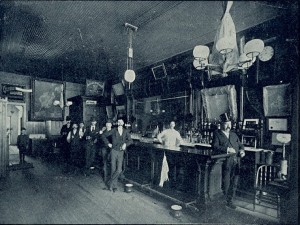Starting in 1854, Chicago beer drinkers made Milwaukee famous. Chicago, with a larger and faster growing population, drank all of the beer its breweries could produce. Milwaukee brewers often produced too much beer. They got in the habit of shipping the excess to Chicago. Over the course of the next century, smaller breweries that did not ship beer began disappearing. The larger breweries got larger and shipped their beer farther. Chicago breweries vanished and Chicagoans had to start drinking beer from Milwaukee, St. Louis and other places.
The 1860 Census, available in our Government Publications Department, shows Cook County with 14 malt liquor manufactures making $572,240 of product. Milwaukee County had 26 manufactures making $310,130. In 1905 Chicago had 56 manufacturers employing 3,303 people and producing $16 million in product. Milwaukee had 8 manufacturers employing 3,809 people and producing $22 million in product.
By 1900 mechanical refrigeration allowed lager breweries to move from tanks in dank cellars with ice overhead to large above-ground tanks. The above-ground tanks were arranged so the liquid would flow by gravity throughout the brewing process.
Chicago saloons also flourished. The City Clerk’s Report shows that by 1907 there were 7219 licensed saloons. One 19th Century innovation was the free lunch provided by saloons throughout the city. Even reformers otherwise critical of the liquor trade were impressed. If Christ Came to Chicago! maintained that the saloons provided more free food to the needy than all other charitable organizations put together. In many cases the lunch was truly free. In other saloons you were expected to buy a five cent beer, but received both a beer and a better lunch than you could get at a regular restaurant for a nickel.
Bottled beer was still a rarity. For beer at home, you went to your local saloon with a pail called a growler. Factory workers used the pails as lunch buckets. They would send a boy off to the saloon to fill the pails with beer. Brewery workers and visitors got all they could drink from the source.
Turn of the century saloons were not without problems. Gem of the Prairie relates how South State Street saloon keeper Mikey Finn was arrested in 1903 for drugging and robbing his customers. He gave his name to knockout drops. Jeffrey Adler's study of homicide in Chicago attributes most 19th Century Chicago murders to senseless drunken brawling. "Stale beer" joints served as flophouses. A two cent purchase of bread, or of the dregs from better saloons, entitled you to floor space for the night.
Lords of the Levee tells the stories of first ward aldermen Hinky Dink McKeena and Bathhouse John Coughlin. They were famous for graft and for hosting the depraved First Ward Ball. Hinky Dink was among the many Chicago saloon keepers who served as aldermen. The first ward included not only the Loop, but the Near South Side vice district of saloons, brothels and gambling dens known as either the "Levee" or “Little Cheyenne.” Cheyenne at the time was known as a Wild West town where cowboys liked to spend several months pay in a single night of debauchery. Reportedly, people in Cheyenne liked to call their red light district "Little Chicago."





Add a comment to: Beer, 1855-1900: Technology That Changed Chicago